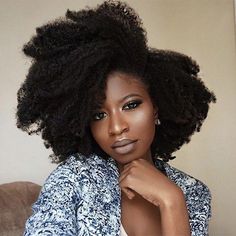
https://i.pinimg.com/236x/ed/e0/3c/ede03c73d0d8f9763d87d8adeb202302.jpg
Hey there, curly coily girl! We see you, and we know it can be hard to find just the right information about your type of curls. At the end of the day, your hair isn’t the same as other curly girls, because your hair requires something different to make it really pop the way you want it to. However, taking care of your curls doesn’t have to be rocket science. Here’s how to care for Type 4 coils. Give these suggestions a look-over and let us know what works for you.
How To Care For Your Type 4 Coils
How to know what your type is:
If you’re just getting started in your curly journey, you may not be totally versed in what your curl type is, and that’s ok. However, since this article is specifically for caring for Type 4 coils, we want to make sure you’re in the right place. When looking at Type 4 coils, one generally noticed the hair is “coiled with an evident ‘S’ or ringlet pattern,” according to hair expert Alicia Bailey, who is the direction of education at Design Essentials. This means your curls may be on the drier side, as the tight coils make it difficult for sebum to move down the shaft. You may notice your curls do have some natural volume, but are also fragile and tend to break easily. Additionally, your curls may knot easily, so understanding how to tend to these tendrils is important for healthy strands.
How to care for your coils:
Bailey’s biggest piece of advice for Type 4 coils is to “handle with care!” Bailey warns that “Coily hair can be fragile, so it’s always best to shampoo trying one’s best to keep the hair in the same direction to aid in detangling.” As a result, you’re going to want to minimize the amount of times you shampoo, and when you do, take your time to carefully and gently scrub your curls Apply a deep conditioner throughout your strands, working section by section so you can be gentle with your strands. When detangling, work through individual knots carefully and thoughtfully. While it can be tempting to rush or to rip your curls, this will only lead to increased damage. Instead, use your fingers or a wide toothed-comb to tackle knots one at a time.
When it comes to products and styling, moisture is key. Make sure you’re investing in good quality products that are designed for your type of curls. When you can., try to avoid over washing or over styling your curls. In fact, the last amount of touching of your strands you can do, the better. Opt for gentle protective styles to help protect your curls between wash days, as well as make sure you aren’t putting your hands in your curls when you can avoid it.
